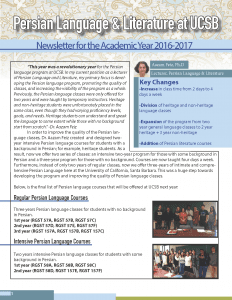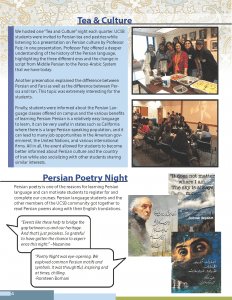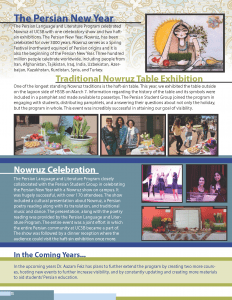Fabio Rambelli
About:
My main field of research and teaching is Japanese religions and cultural history, and especially the Esoteric Buddhist tradition (mikkyō) and the history of Shinto. In particular, I have been studying the interactions between Buddhism and local cults in several Asian traditions on the one hand, and the history of the development of the Shinto discourse in Japan on the other. I envision Shinto as the result of complex processes involving both the localization of Buddhism (as an originally translocal religion) in Japan and the opening of the Japanese tradition to several Asian intellectual trends (such as Neo-Confucianism and Daoism from China, but also Neo-Brahmanism from India, and, later, Christianity from the West), together with an enhanced awareness of cultural identity and specificities. I am currently working on the religious and intellectual components of gagaku and bugaku, the music and dance of the Japanese imperial court, and more specifically on a cultural history of one of this genre’s instruments, the shō (a bamboo mouth organ). As part of that project, I have created a study group where we practice instruments and organize events and initiatives related to Gagaku. I am also interested in the impact (often downplayed or ignored) of Indian cultural elements on pre-modern Japan; in issues of cultural identity (especially in Japan and in Italy, and on the representations of Italy circulating in Japan); and in more general themes in the history of religions (such as materiality, semiotics, iconoclasm, and syncretism).
Music Recordings
The Turning Point (CD and digital CD), by Fabio Rambelli (shō) and Dirk Wachtelaer (drums and percussions). October 2024. Edgetone Records.
New Heritage (CD and digital CD), by Fabio Rambelli (shō), Thomas Piercy (hichiriki), and Lish Lindsey (ryūteki). November 2023. Edgetone Records.
Pearls (CD and digital CD), by Neo Archē (Fabio Rambelli: shō and uchimono and Rory Lindsay: gaku-biwa with guests), April 2023. Edgetone Records.
Neo Archē (digital CD), by Fabio Rambelli and Rory Lindsay (September 2020). Fabio Rambelli, shō; Rory Lindsay, gaku-biwa.
Yellow Flower (CD), by Sofar Sonear (Jazztone, 2017). Fabio Rambelli, saxophones and flutes; Michael Hällstrom, guitars; Tevfik Bultan, double bass; John Knecht, drums and percussion.
Karma Blues. Fabio Rambelli: fujara, khaen, tenor saxophone; Stefano Calvano: percussion. From CD Art Jungle by Stefano Calvano (Jazztone, 2013).
Publications:
- Buddhism Under Capitalism. Edited by Richard K. Payne and Fabio Rambelli. London and New York: Bloomsbury, 2023.
- Rituals of Initiation and Consecration in Premodern Japan: Power and Legitimacy in Kingship, Religion, and the Arts. Edited by Fabio Rambelli and Or Porath. Berlin: De Gruyter, 2022.
- Bloomsbury Handbook of Japanese Religions. Edited by Erica Baffelli, Andrea Castiglioni, and Fabio Rambelli. London and New York: Bloomsbury, 2021.
- Defining Shugendō: Critical Studies on Japanese Mountain Religions. Edited by Andrea Castiglioni, Fabio Rambelli, and Carina Roth. London and New York: Bloomsbury, 2020.
- Materiality of Religion in Japan, special issue of Japanese Religions (vol. 43/1-2), edited by Jørn Borup and Fabio Rambelli (August 2019).
- Spirits and Animism in Contemporary Japan: The Invisible Empire. Edited by Fabio Rambelli. London and New York: Bloomsbury, 2019.
- The Sea and the Sacred in Japan: Aspects of Maritime Religiosity. Edited by Fabio Rambelli. London and New York: Bloomsbury, 2018.
- Aspects of Shinto in the Muromachi Period. Guest editor Fabio Rambelli. Special issue of Japanese Religions, nr. 42, 2017
- Zen Anarchism: The Egalitarian Dharma of Uchiyama Gudō. Berkeley: Institute for Buddhist Studies, 2013.
- A Buddhist Theory of Semiotics. London and New York: Bloomsbury, 2013.
- Buddhism and Iconoclasm in East Asia: A History. Fabio Rambelli and Eric Reinders. London and New York: Bloomsbury, 2012.
- Mitarai Shōji 御手洗昭治, Ogasawara Haruno 小笠原はるの, and Fabio Rambelli ファビオ・ランベッリ. Tabunka kōryū jidai e no chōsen 多文化交流時代への挑戦. Tokyo: Yumani shobō, June 2011.
- Buddhist Materiality: A Cultural History of Objects in Japanese Buddhism. Stanford. Stanford University Press, 2007.
- Japanese translation of Franco Cassano, Il pensiero meridiano (Bari: Laterza, 1996) as Minami no shisō 『南の思想』. Tokyo: Kōdansha 講談社, 2006.
- Itariateki: Minami no miryoku 『イタリア的—「南」の魅力』 Tokyo: Kodansha 講談社, 2005 (2nd reprint, 2007)
- Buddhist Semiotics (Web publication) www.semioticon.com = CyberSemiotic Institute = Buddhist Semiotics or http://www.chass.utoronto.ca/epc/srb/cyber/cyber.html, completed August 2003).
- Buddhas and Kami in Japan: Honji Suijaku as a Combinatory Paradigm. Edited by Mark Teeuwen and Fabio Rambelli. London and New York: Routledge, 2002.
- Vegetal Buddhas: Ideological Effects of Japanese Buddhist Doctrines on the Salvation of Inanimate Beings. Kyoto: Kyoto: Italian School of East Asian Studies (Occasional Papers 9), 2001.
- Reconfiguring Cultural Semiotics: The Construction of Japanese Identity. Edited by Fabio Rambelli and Patrizia Violi. Special issue of Versus: Quaderni di studi semiotici nos. 83/84, May-December 1999 (published December 2000)
- Itariateki kangaekata: Nihonjin no tame no Itaria nyūmon 『イタリア的考え方:日本人のためのイタリア入』. [The Italian Way of Thinking: An Introduction to Italy for the Japanese]. Tokyo: Chikuma shobō 筑摩書房, 1997 (8th reprint, 2005)
Articles:
“The Economic Study of Buddhism,” by Richard K. Payne and Fabio Rambelli. In Richard K. Payne and Fabio Rambelli, eds., Buddhism Under Capitalism: 1–22. London and New York: Bloomsbury, 2022.
“Gagaku in Medieval Japanese Religions,” Religions n. 13, 582, 2022. Special issue on Medieval Japanese religions, edited by Bernard Faure and Andrea Castiglioni.
“Shō kanjō: Music Education, Secret Melodies, and Imperial Politics.” In Rambelli and Porath, eds. Rituals of Initiation and Consecration in Premodern Japan: 435–460. Berlin: De Gruyter, 2022.
“General Introduction: Rituals of Initiation and Consecration (kanjō) in Premodern Japan,” by Fabio Rambelli and Or Porath. In Rambelli and Porath, eds. Rituals of Initiation and Consecration in Premodern Japan: 1–30. Berlin: De Gruyter, 2022.
“The Sutra of Druma, King of the Kinnara and the Buddhist Philosophy of Music.” In Giovanni Bulian and Silvia Rivadossi (eds.), Itineraries of an Anthropologist. Studies in Honor of Massimo Raveri, pp. 181–197. Venice: Edizioni Ca’ Foscari, 2021.
“The Dharma of Music: Gagaku and Buddhist Salvation in Medieval Japan,” Japanese Journal of Religious Studies, 48/1, Spring 2021, pp. 45–71.
“The Mystery of Wealth and the Role of Divinities: The Economy in Pre-Modern Japanese Fiction and Practice.” Hualin International Journal of Buddhist Studies, vol. 2 nr. 2, October 2019, pp. 163-201.
“Dharma Devices, Non-hermeneutical Libraries, and Robot-Monks: Prayer Machines in Japanese Buddhism,” Journal of Asian Humanities at Kyushu University vols. 3-4, pp. 1-19 (March 2018).
“Materiality, Labor, and Signification of Sacred Objects in Japanese Buddhism,” Journal of Religion in Japan 6/1 (2017), pp. 1-26.
“The Vicissitudes of the Mahāsammata in East Asia: The Buddhist Origin Myth of Kingship and Echoes of a Republican Imagination,” Medieval History Journal, 17/2 (2014), pp. 1-21.
“Floating Signifiers: The Plural Significance of the Grand Shrines of Ise and the Incessant Re-signification of Shinto,” Japan Forum, no. 27, 2014, pp. 221-242.
“Muhammad Learning the Dao and Writing Sutras: Early Japanese Representations of Muhammad,” in The Image of the Prophet between Ideal and Ideology, edited by Christiane J. Gruber and Avinoam Shalem. Leiden: de Gruyters, 2014.
“Gods, Dragons, Catfish, and Godzilla: Fragments for a History of Religious Views on Natural Disasters in Japan,” in Roy Starrs, ed., When Tsunami Comes to Shore: Culture and Disaster in Japan. Leiden and Boston: Brill, 2014.
“The Idea of India (Tenjiku) in Premodern Japan: Issues of Signification and Representation in the Buddhist Translation of Cultures,” in Buddhism Across Asia, ed. by Tansen Sen. Vol. 1, pp. 259-290. Singapore: Institute of South East Asian Studies Publishing, 2014.
“Sada Kaiseki: An Alternative Discourse on Buddhism, Modernity, and Nationalism in the Early Meiji Period,” in Roy Starrs, ed., Politics and Religion in Japan: Red Sun, White Lotus (London: Palgrave MacMillan, July 2011), pp. 104-142.
“The Story of Prince Rama in Japan: Sources and Transformations.” In Ramayana in Focus: Visual and Performing Arts of Asia. Ed. By Gauri Parimoo Krishnan. Singapore: Asian Civilisation Museum, 2010, pp. 28-37.
“Buddhist Environmentalism: Limits and Possibilities,” Poetica 80 (special issue on “Japan and Ecocriticism,” eds. David Bialock and Ursula Heise), 2013, pp. 21-49.
“Re-positioning the Gods: “Medieval Shinto” and the Origins of a Non-Buddhist Discourse on the Kami,” Cahiers d’Extrême-Asie 16, 2006-2007 (Winter 2009), pp. 305-325.
“Before the First Buddha: Medieval Japanese Cosmogony and the Quest for the Primeval Kami,” Monumenta Nipponica 64/2, Autumn 2009, pp. 235-271.
“Buddhist Republican Thought and Institutions in Japan: Preliminary Considerations,” in Japanese Studies Around the World 2008, Special Issue “Scholars of Buddhism in Japan: Buddhist Studies in the 21st Century.” Kyoto: International Research Center for Japanese Studies, (March 2009), pp. 127-153.
“Secrecy in Japanese Esoteric Buddhism,” in The Culture of Secrecy in Japanese Religion. Edited by Mark Teeuwen and Bernhard Scheid. London and New York: Routledge, 2006, pp. 107-129.
“‘Just Behave as You Like’: Radical Amida Cults and Popular Religiosity in Premodern Japan,” in Richard K. Payne and Kenneth K. Tanaka, eds., “Approaching the Land of Bliss: Religious Praxis in the Cult of Amitabha.” Honolulu: University of Hawai’i Press, 2004, pp. 169-201.
“The Emperor’s New Robes: Processes of Resignification in Shingon Imperial Rituals,” in Buddhist Priests, Kings, and Marginals: Studies on Medieval Japanese Buddhism, ed. by Bernard Faure. Special issue of the Cahiers d’Extreme-Asie 13, 2002-2003, pp. 427-453.
“The Ritual World of Buddhist ‘Shinto’: The Reikiki and Initiations on Kami-related Matters (jingi kanjo) in Late Medieval and Early-Modern Japan,” Japanese Journal of Religious Studies 29/3-4, Fall 2002, pp. 265-297.
“Secret Buddhas (Hibutsu): The Limits of Buddhist Representation,” Monumenta Nipponica 57/3, Autumn 2002, pp. 271-307.
“Tantric Buddhism and Chinese Thought in East Asia,” in David Gordon White, ed., Tantra in Practice. Princeton: Princeton University Press, 2000: 361-380.
“The Empire and the Signs: Semiotics, Cultural Identity, and Ideology in Japanese History,” in Reconfiguring Cultural Semiotics: The Construction of Japanese Identity. Special issue of Versus: Quaderni di studi semiotici 83/84, maggio-dicembre 1999, (published in December 2000), ed. by Fabio Rambelli and Patrizia Violi, pp. 15-40.
“Religion, Ideology of Domination, and Nationalism. Kuroda Toshio on the Discourse of Shinkoku,” in The Legacy of Kuroda Toshio, edited by James C. Dobbins, special issue of the Japanese Journal of Religious Studies 23/3-4 Fall 1996, pp. 387-426.
“True Words, Silence, and the Adamantine Dance. On Japanese Mikkyo and the Formation of the Shingon Discourse,” Japanese Journal of Religious Studies 21/4, December 1994: pp. 373-405. Now reprinted in Buddhism (Critical Concepts in Religious Studies), vol. 6. Ed. by Paul Williams. London: Routledge, 2005.
















